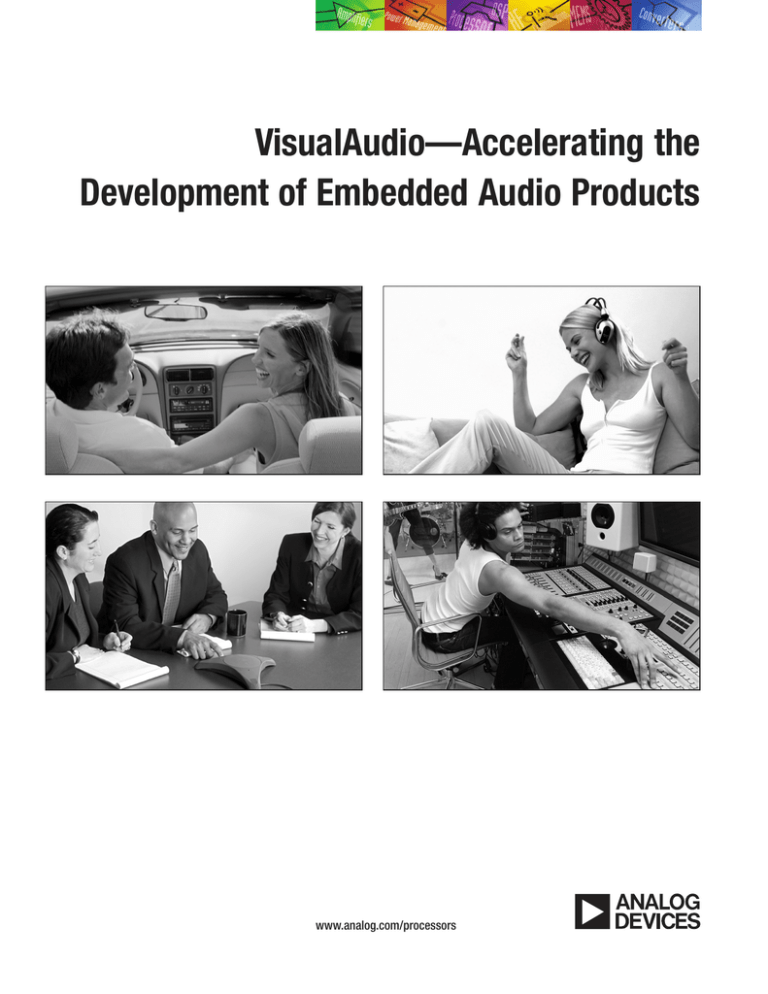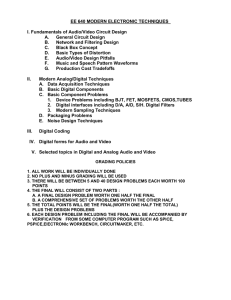
VisualAudio—Accelerating the
Development of Embedded Audio Products
www.analog.com/processors
VisualAudio—Accelerating the Development
of Embedded Audio Products
Introduction
Engineers involved in the design and development of next generation audio products are being impacted by
several market trends. First, the complexity of products is increasing due to the continued introduction of new
audio formats, the need to play back several simultaneous content streams, and the steady migration of high
end features, such as automatic room equalization, into consumer level products. Second, audio products are
emerging that contain a significant amount of overall software complexity, such as network stacks. Examples
include networked audio players and digital video recorders. Often software engineers without a solid background in audio processing or sound quality issues are charged with incorporating audio features.
This paper provides an overview of VisualAudio®, a graphical development environment from Analog Devices,
Inc. (ADI) that is specifically aimed at audio development engineers. VisualAudio provides many of the software
building blocks, together with an intuitive graphical interface, for designing, configuring, and tuning audio
systems. VisualAudio consists of the following components:
Audio Module Library—A collection of optimized real-time audio processing functions sufficient
for developing many different types of audio products. Separate versions exist for SHARC® and
Blackfin® Processors.
VisualAudio Designer—A PC application for graphically creating audio processing networks.
VisualAudio Designer can use audio processing functions supplied in the Audio Module Library or custom
user-written functions.
Example Platforms—These real-time frameworks make it easy to develop systems on EZ-KIT Lite®
evaluation hardware provided by Analog Devices. Source code is provided for all example platforms, and
they serve as convenient starting points for product development.
VisualAudio works in conjunction with VisualDSP++®, the development and debugging environment for SHARC
and Blackfin Processors. VisualAudio generates optimized product-ready code and simplifies developing
complex audio processing software. VisualAudio benefits development engineers by reducing development
cost, risk, and time to market. This paper discusses the features and benefits of VisualAudio, and describes
how the tool is used during a typical product development cycle.
VisualAudio—Accelerating the Development of Embedded Audio Products
Analog Devices, Inc.
2
www.analog.com/processors
SHARC and Blackfin Processor Families
Digital signal processors (DSPs) have become the platform of choice for audio products because their
programmability allows them to be quickly customized to a specific market or application. The SHARC and
Blackfin Processor families from ADI are particularly well-suited for this task and are being used in consumer,
automotive, and professional applications.
VisualAudio was originally written for the SHARC Processor, and its coverage has recently been expanded to
include the Blackfin Processor. Currently, VisualAudio supports the SHARC ADSP-2126x and ADSP-2136x
processor families as well as all Blackfin Processors. These two processors are quite different. The SHARC is a
32-bit, SIMD, floating-point DSP with a large internal memory. The Blackfin is a high-clock-rate, 16-bit, SIMD,
fixed-point DSP with 32-bit embedded microcontroller capabilities (such as instruction and data caches, high
performance external SDRAM interface, and significant general-purpose extensions to the instruction set).
The Blackfin also has extensive power management features, making it suitable for portable battery-powered
devices. Both processors come in a variety of models, many with integrated audio peripherals such as
asynchronous sampling rate converters, S/PDIF transceivers, etc.
Despite their differences, both processors are supported by VisualAudio. Complementary audio module
libraries allow processing networks to be easily moved between processors. In the SHARC implementation, the
signal type is 32-bit floating-point; on the Blackfin, it is 32-bit (double precision) fixed-point. The SHARC is
aimed at high end products requiring sophisticated audio processing, such as AVR receivers, digital automotive
amplifiers, or professional studio equipment. The Blackfin is finding application in portable products such
as MP3 decoders or networked audio players.
DSP Software Architecture
VisualAudio divides the DSP architecture into two separate portions. The framework is responsible for
processor initialization, audio I/O, decoders, host communication, and control. The layout consists of the
real-time audio processing functions, audio parameters and state variables, and a tuning interface for making
parameter changes while audio is being processed. In VisualAudio, frameworks and layouts are, for the
most part, decoupled, allowing layouts to be easily migrated between different frameworks.
On the DSP, the interface between the framework and the layout consists of buffers of audio data. These
buffers are filled by the framework, processed by the layout, and then returned to the framework. Each buffer
contains a block of audio data, and the processing is done in place by the layout. The processing is illustrated
in Figure 1.
AUDIO MODULE
RENDER FUNCTIONS
REAL-TIME
AUDIO I/O
VISUALAUDIO
LAYOUT
SUPPORT
LIBRARY
AUDIO MODULE
DATA STRUCTURES
GENERATED BY
THE VISUALAUDIO
DESIGNER
FRAMEWORK
AUDIO INPUT
AND OUTPUT
BUFFERS
LAYOUT
Figure 1. Overview of the real-time DSP architecture showing the interaction between the platform and the layout.
VisualAudio—Accelerating the Development of Embedded Audio Products
Analog Devices, Inc.
3
www.analog.com/processors
The division between framework and layout also exists on the PC, and platforms serve as interfaces between
VisualAudio Designer, the framework, and VisualDSP++. This is illustrated in Figure 2. The platform encompasses a Platform File and a Platform Project. The Platform File is an XML file that describes the capabilities of
the framework (and thus the target hardware) to VisualAudio Designer. For example, it lists the number of audio
inputs and outputs, processor type, processor speed, etc. The Platform Project is a VisualDSP++ project that
builds the final executable. It references the framework, source files generated by VisualAudio Designer, realtime audio processing functions, and related libraries. The Platform Project is managed independently outside
of VisualAudio.
AUDIO
MODULE
XML FILES
LAYOUT FILE
(.VAL)
SYSTEM FILE
(.VAS)
“PLATFORM”
FRAMEWORK
SOURCES
AND LIBS
AUDIO
PROCESSING
FUNCTIONS
PLATFORM
XML FILE
VISUALDSP
PROJECT FILE
(.dpj)
VISUALAUDIO DESIGNER
GENERATED
LAYOUT
SOURCE FILES
LAYOUT
SUPPORT
LIBRARY
VISUALDSP++
EXECUTABLE
Figure 2. PC tool flow showing the relationship between VisualAudio Designer, VisualDSP++, and the platform.
Development Process
Different skills are needed to develop the platform and layout, and these tasks are often done by separate
engineers. In the discussion that follows, we will refer to the person writing the framework code as the
embedded software engineer, and the person developing the layout as the audio engineer. VisualAudio
Designer is used to design, configure, and tune audio processing layouts, and will thus primarily be used by the
audio engineer.
The steps involved in using VisualAudio for product development are shown in Figure 3 and described in
detail below.
1. The audio engineer begins by selecting a hardware reference board that can be used to prototype and
refine the audio processing. The reference board contains a superset of the memory and peripherals found
in the final product, and can be used to start development of the audio layout prior to having actual target
hardware. Analog Devices provides EZ-KIT Lites for most SHARC and Blackfin Processors. VisualAudio
provides example platforms that operate on many of the EZ-KIT Lites. These platforms are actually complete
systems that include I/O, buffering, an interface to the layout, and also a platform file.
VisualAudio—Accelerating the Development of Embedded Audio Products
Analog Devices, Inc.
4
www.analog.com/processors
2. The audio engineer designs the audio processing layout, including writing any custom audio modules.
Inspectors are used to configure audio module parameters.
3. VisualAudio generates source files that describe the layout and, together with the example platform,
run on the reference hardware.
4. In parallel, the embedded software engineer develops the framework for the target hardware. The
framework initializes the processor, manages the I/O, and buffers audio into blocks. The embedded
software engineer starts with one of the example platforms supplied with VisualAudio. Source code is
provided, allowing them to be customized to the target hardware.
5. The embedded software engineer incorporates the VisualAudio Layout Support Library. The library
provides the run-time interface to the audio processing and can be tested with a simple layout created
with VisualAudio.
6. Once the framework is debugged, the embedded software engineer creates and publishes a platform
file. This platform file enables VisualAudio Designer to generate layout code for the target platform.
A platform project is also created, which ties together all of the DSP software components needed to
build the executable.
7. At this point, the embedded software engineer and the audio engineer share files. This enables the
audio layout designed by the audio engineer to execute on the target hardware.
8. The audio engineer can continue to use the full capabilities of VisualAudio on the target hardware.
This includes updating the layout, tuning the system, and creating presets.
AUDIO ENGINEER
2
DESIGN AND
CONFIGURE THE
AUDIO PROCESSING
LAYOUT
3
GENERATE CODE
AND TEST ON
THE EZ-KIT
DEVELOP BLOCKBASED PLATFORM
FOR THE TARGET
HARDWARE
4
INCORPORATE THE
LAYOUT SUPPORT
LIBRARY. TEST WITH
A SIMPLE LAYOUT.
5
CREATE THE
PLATFORM XML
6
S
LE
FI
SELECT AN EZ-KIT
DEVELOPMENT
PLATFORM
UT
YO
LA
1
EMBEDDED
SW ENGINEER
EXAMPLE
SYSTEM
S
FILE
RM
TFO
A
L
P
TOOL
GENERATED
LAYOUT FILES
FINAL
PLATFORM
FILES
SHARE FILES
7
COMPLETE
SYSTEM
CONTINUE
DEVELOPMENT
WITH VISUALAUDIO
8
Figure 3. Typical development process used with VisualAudio.
VisualAudio—Accelerating the Development of Embedded Audio Products
Analog Devices, Inc.
5
www.analog.com/processors
Open and Extensible
Audio system developers have a significant investment in design techniques, tool chains, and audio algorithms.
Introducing a new development tool can be time consuming and risky if it does not interface well with existing
tools. VisualAudio was designed with this in mind, and offers several features that allow it to work in conjunction with other software tools and to be customized to a specific hardware platform.
The VisualAudio audio module library can also be extended through an open API. The user or third parties can
create custom audio modules in C or assembly language, and these new modules are easily included within
the VisualAudio design environment. Source code for the entire library of the ADI supplied audio modules is
included together with detailed documentation and examples.
The VisualAudio software framework is based on a modular driver model. Well-defined interfaces for audio
I/O, host communication, and audio decoders are provided. These functions can be customized by users for
their particular hardware, and example source code is provided for ADI reference hardware.
Summary
The complexity of digital signal processing software within audio products continues to increase due to the
introduction of new audio formats and the desire to offer unique and differentiating features. To address
this, ADI has developed VisualAudio, an integrated audio software development environment. VisualAudio
simplifies audio product development by providing engineers with many of the key software building blocks
found in audio systems, together with an intuitive graphical interface. VisualAudio jump-starts product
development; reduces development cost, time, and risk; and allows engineers to focus on innovation and
product differentiation.
VisualAudio—Accelerating the Development of Embedded Audio Products
Analog Devices, Inc.
6
www.analog.com/processors
Analog Devices, Inc.
Worldwide Headquarters
Analog Devices, Inc.
One Technology Way
P.O. Box 9106
Norwood, MA 02062-9106
U.S.A.
Tel: 781.329.4700
(800.262.5643,
U.S.A. only)
Fax: 781.461.3113
Analog Devices, Inc.
Europe Headquarters
Analog Devices SA
17-19 rue Georges Besse
Antony, 92160
France
Tel: 33.1.46.74.45.00
Fax: 33.1.46.74.45.01
Analog Devices, Inc.
Japan Headquarters
Analog Devices, KK
New Pier Takeshiba
South Tower Building
1-16-1 Kaigan, Minato-ku,
Tokyo, 105-6891
Japan
Tel: 813.5402.8200
Fax: 813.5402.1064
Analog Devices, Inc.
Southeast Asia
Headquarters
Analog Devices
22/F One Corporate Avenue
222 Hu Bin Road
Shanghai, 200021
China
Tel: 86.21.5150.3000
Fax: 86.21.5150.3222
Embedded Processing
and DSP Support
U.S.A.:
processor.support@analog.com
Fax: 781.461.3010
Europe:
processor.europe@analog.com
Fax: 49.89.76903.157
www.analog.com/processors
© 2006 Analog Devices, Inc. All rights reserved.
Trademarks and registered trademarks are the property
of their respective owners.
Printed in the U.S.A.
TO5893-0-1/06
w w w. a n a l o g . c o m / p r o c e s s o r s



